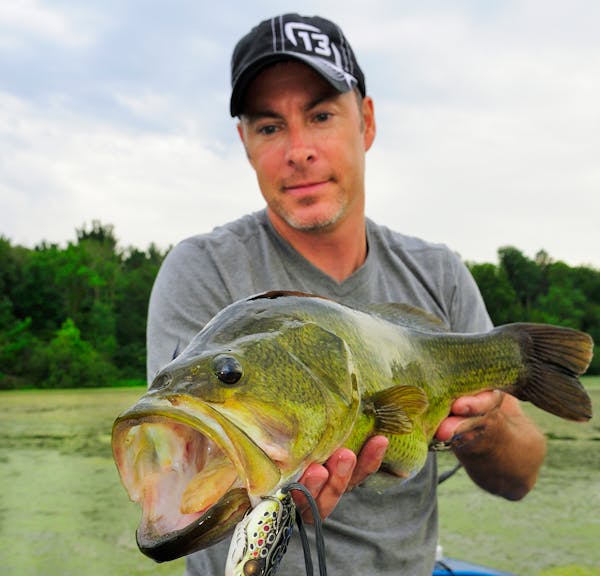Hindsight being what it is, Anthony Hauck knew better. A couple of summers back, the temperature was high and the air was thick with humidity. He recognized the conditions, but wanted to bring his older English cocker spaniel, Sprig, outside for a brief training session. Just five minutes of throwing a bumper to the pup, he told himself.
It wasn't long after, more than a minute, but certainly less than five, that Sprig had an absent look in her eyes. She started to wobble as she walked, and there was foam around her mouth. Recognizing some of the symptoms of heat exhaustion, potentially serious, Hauck hurried Sprig to the veterinarian, where she cooled down and made a full recovery. But it's an experience the Lino Lakes man won't forget.
"It was a really scary deal, and there was that real-life realization that something like that can happen in just a minute," said Hauck, a dog lover and public relations director for Pheasants Forever. "When you have a hunting dog, or a working dog, they want to be active and you want them to be active and ready for the upcoming fall. At the same time, you want them to be around for 12 or 14 years."
For dogs and their human companions, summer is a great time to frolic about and explore the world. Nevertheless, Hauck and countless other dog owners have learned, there is plenty that can go wrong, too, and it can happen quickly. Following are four tips for ensuring your dog, whether he's a hunter or a family pet — or both — stays safe when the mercury climbs.
Keep 'em cool
Mark Haglin, who has owned Pine Shadows Kennels in Brainerd since 1976, works with dogs just about every day. He hunts with them. He trains them. He walks them. His biggest concern about dogs during the summer is that they'll become overheated. It's important to give them ready access to shade and water, and to be prepared with a wet blanket if there isn't water to dunk them in.
"When we are training, we have a little plastic tub that's always full of water," Haglin said. "The dogs will be working out in the field and then hop in the tub."
Lakes and other bodies of water are great places for dogs to cool off, but some don't like the water or lack strong swimming skills, said Dr. Jerry Klein, chief veterinary officer for the American Kennel Club. "Be conscious of your dog's preferences and skills before putting him in the water.
Klein also noted that dogs can get overheated or burn the pads on their paws when walking on hot asphalt. It's a good idea for dog owners to pay attention to their pets' body temperature, which is why Hauck keeps a thermometer with him. A temperature of 101 to 102.5 degrees is normal. Anything above that and they've got a fever, which could necessitate a trip to a physician.
Clean water, and plenty of it
Hauck admitted he is a stickler when it comes to water. He wants his dogs to get enough, of course, because proper hydration is just as important to them as it is to humans. When he's out with Sprig and his other dog Smidge (also an English cocker spaniel) and they're tempted to drink from a wetland or a puddle in the road, Hauck has no qualms about deploying that "No" command on which he's worked so hard.
"I don't let my dogs drink any water other than what I supply them," Hauck said. "You just don't know anything about those other water sources. If you carry water with you, at least they're familiar with it and you know it's clean."
He carries a water bottle with a cap that screws off and doubles as a drinking bowl. Other dogs learn to drink from a squirt bottle, or from a Camelbak system that's popular with cyclists and runners. And when he takes his dogs camping, Hauck packs along a 5- or 8-gallon jug full of water. The key, he said, is maintaining consistency when it comes to their water source, because dogs with sensitive stomachs may react negatively to unfamiliar water.
"It's not always just about preventing the major thing," Hauck said. "Who wants a dog with diarrhea for three days?"
Keep the bugs at bay
All dogs should have routine flea and tick treatments, Klein said. Frontline is among the most popular, and is what Haglin has used for years. Hauck has switched to a chew tablet called Bravecto, which lasts for 12 weeks. Whatever people choose, the key, Hauck said, is to give dogs the treatment as often as the makers recommend. "I've got it on my calendar," Hauck said.
While Hauck and Haglin treat their dogs, they also check them each time they're afield or somewhere where ticks are present. Hauck starts at the head and works his way backward, using his fingers to feel every inch of his dogs' bodies. "If you overlook a spot, you'll probably miss one," he said.
Said Haglin: "If we're going out for a walk in the woods or on a trail, we check ourselves [for ticks], so we give the dogs a once-over, too. It's easy to do with a little brush. You can often brush out a tick before it gets attached."
Even though he treats his dogs and checks them regularly for ticks, Haglin also watches for signs of Lyme disease. That's especially important this time of year, as dogs that were bit in the spring will start showing symptoms. "You'll start to see the symptoms [now] if you missed the initial tick bite," he said. "The first thing we usually notice is a lameness in one leg or the other. And it may not be the same leg every day. Or maybe they're a little lethargic. They may not be moping around, but they're not real excited about getting out and about."
Dog owners who suspect Lyme need to visit the animal doctor.
One more tip from Haglin: Watch for signs your dog's been bit by another type of bug, such as a deerfly or horsefly. Dogs react differently to those bites, and some will have swollen faces or eyes. Haglin treats bites with Benadryl, but will take a dog to the veterinarian if it doesn't improve from that treatment.
Algae avoidance
Still, sunny and warm summer days are tailor-made for bringing the dog to a park or other outdoor area. The weather also is ripe for growth of blue-green algae, which are types of bacteria that can be lethal for dogs. Blue-green algae may look like pea soup or green paint, according to the Minnesota Pollution Control Agency (MPCA). Outbreaks can occur almost anywhere in the state, occurring most frequently in nutrient-rich and warm shallow water.
Symptoms such as diarrhea, difficulty breathing, seizures or weakness may occur shortly after exposure, according to the MPCA.
"Pets, especially dogs, are susceptible to harmful algae because they swallow more water while swimming and doing activities like retrieving a ball from the water," according to the MPCA website. "They are also less deterred by green, smelly water that may contain harmful algae."
Hauck keeps his dogs out of the water, unless it has some current or he's at a cold, deep lake in the northern part of the state. If he's in a place where conditions might foster blue-green algae, he plays it safe.
"I just really don't let me dogs go in the water in southern Minnesota," Hauck said.
Joe Albert is a freelance writer from Bloomington. Reach him at writerjoealbert@gmail.com.
Minnesota's Naz Reid wins NBA's Sixth Man of the Year award, edging Malik Monk in close vote

